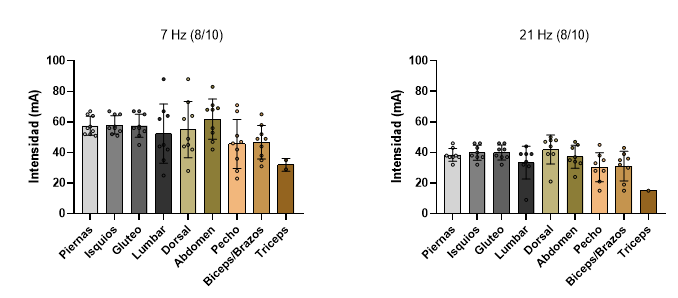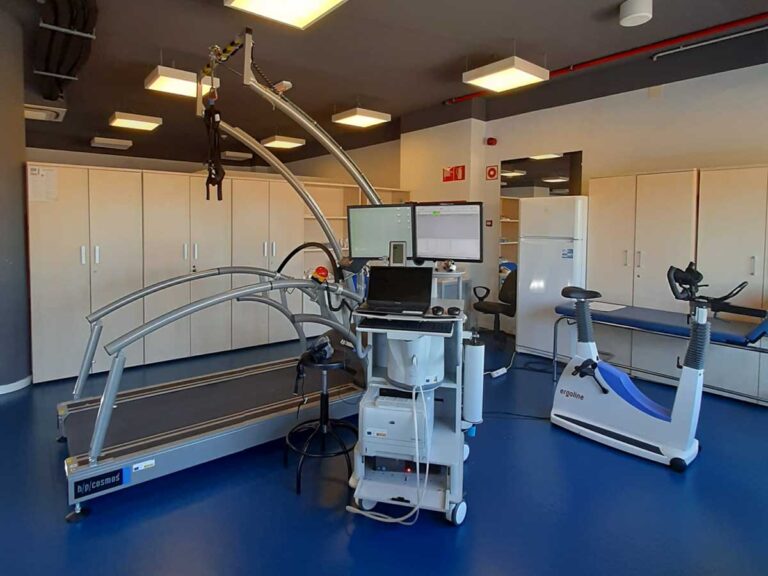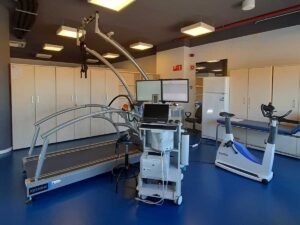In the previous post “This is how the electrical intensity determines the results of our training” we made a brief analysis of the electrical intensities that are supported at the RPEs that we set at the beginning of the investigation (5/10, 7/10 and 8/10) .
We were able to verify that an average increase of approximately 20 mA could result in an increase of up to 50 bpm in heart rate; however, these results are averages of all participants. In the following image we verified that there was some variability (distance between points) for all muscle groups:

It can be seen that, for example, in the lumbar, dorsal and abdominal areas the variability is even greater at 7 Hz; however, we see that at 21 Hz the variability is reduced, although we continue to have disparity between participants.
For example, if we analyze the abdomen at 21 Hz we see that there are people who support approximately 10 mA, while others are able to support up to 40 mA. The difference in these intensities can be due to different causes:
- The physiognomy of each participant is different, so the body structure itself may not allow the electrodes to be completely tight to the body.
- The diversity of electrostimulation suits used has been able to enhance the difference between body structures, with the use of the Slim Plus personal EMS suit being the most affected, since the Revolution Pro shared-use EMS suit allows us to adjust each electrode to each muscle group.
- Body composition can affect the delivery of electrical current. The relationship between fat % and electrical current administration has been previously studied, and the higher the fat %, the worse conductivity, so a higher intensity is necessary.
- The experience with electrostimulation. People who have had more experience with EMS require a higher electrical intensity to increase heart rate. They are more tolerant.
Assessment
With the data we collected at Wiems Lab we have carried out this same analysis, but the results are not entirely conclusive:

We can see that each participant has 3 variables:
- With and without experience in EMS.
- Cantidad de tejido adiposo visceral (VAT).
- % fat measured with DXA.
Likewise, they were divided according to those who had endured greater electrical intensity in the lumbar, dorsal, and abdomen; and the value of the electrical intensity withstood.
Results
We observed in both groups (people who endure more or less intensity) their experience or not with EMS.
In both groups we have people with high and low visceral adipose tissue. For example, in the group that has endured the least electrical intensity we have P3 with 361 grams of visceral adipose tissue and P2 with 145. Similarly, in the group that has endured the greatest electrical intensity we have people at P6 with 253 grams of adipose tissue. visceral and P7 with 185 gr. It should be noted that all of them are below 400%, so in no case could we say that there are people with a lot of visceral fat and people with very little. All of them are in normative values of visceral adipose tissue.
Finally, and as a result of the above, we have the % fat measurements that, in the same way, show a normative state of body composition for this population. The % fat values are between 14.3 and 34.2 %, which means that they are within the normal range for this population.
In view of the current results, we cannot confirm that there is a direct relationship between body composition and electrical intensity supported; and we cannot conclude that the experience with EMS is a determining variable for intensity regulation.
In this sense, the new Wiemspro application for trainers has an integrated report for each workout on the intensity supported and the relationship with heart rate, weight and fat %. This new functionality thus helps us to answer the question with great ease: Does body composition affect the administration of electrical current?
Conclusion
The analysis carried out in Wiems Lab has been totally observatory. We wanted to check with a very small number of people if any trend could be seen. However, the data is not enough; For all these reasons, we conclude that:
- A priori there does not seem to be a relationship between body composition, experience with EMS and electrical intensity supported by the individual.
- The variability in electrical intensity may be due to the fact that the person is not able to establish what is a 5/10, a 7/10 and an 8/10 on the RPE scale.
Unai Adrian Perez de Arrilucea
Wiems Lab Team







